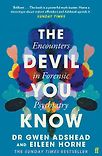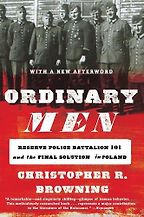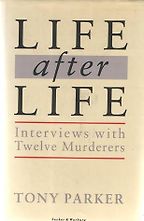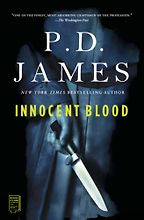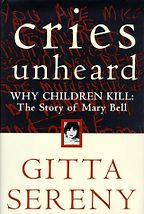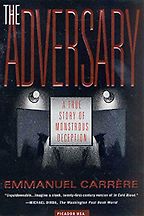Let’s start by looking at the topic you’ve chosen: the psychology of killing. How did you become interested in this area?
I’m a forensic psychiatrist and psychotherapist. A forensic psychiatrist is someone who specialises in the assessment and treatment of people who have offended while they were in some kind of abnormal mental state. There are two questions there: first, the legal question—does this abnormal state affect their legal responsibility?—and secondly, if the offender is mentally ill, do they need to be treated in secure hospital rather than go to prison?. That treatment will be designed to look not only at their mental health, but also their risk to the public.
Mental health problems are rarely a risk factor for crime generally, so a forensic psychiatrist won’t be dealing with people who are committing minor crimes, like shoplifting . We tend only to get involved in crimes of violence, and usually where that violence has been fatal. So most of my working life has involved assessing people who have committed serious acts of violence, or who are threatening to do so. For a long time I ran a therapy group for people who had killed a family member while they were mentally ill. I’ve also been involved in assessing mothers who have been abusive, or are considered at risk of abusing their children.
So this has been my bread and butter for about thirty years—an interest in the mental states that give rise to killing.
The obvious question, to me, is: if one commits murder, does that not indicate that, almost by definition, that the assailant is undergoing an abnormal mental state?
That question has always been of great significance, and one that humans have asked themselves for thousands of years. What is fascinating about humans is the many ways in which we do kill each other. We are one of the few animals that kill each other in different ways. Chimpanzees, for example, do have very serious fights, competitions over power, which can be fatal. And chimpanzee tribes can wage war on other chimpanzee tribes, killing in the process. But killing in the way that we kill appears to be pretty unique. Killing over territory is one thing, but we also kill over money, over politics and in the context of relationship disturbance; and that last context is quite unusual.
For as long as we have had recorded data about humans, we’ve written about the impact of murder. I don’t think there’s legislation in any culture in any age which hasn’t set aside some kind of law or ruling about how and when you can kill somebody, and what should happen to people who kill.
“The question of the mental state that a person is in when they kill is of great interest to the criminal courts”
Take the Old Testament. There are rules in there about killing that are very specific. The Ten Commandments separate killing from murder, for example. Traditionally, in many cultures, if you killed somebody, you had to make restitution to their family. That didn’t always mean being killed yourself. Different countries and ethnic groups have had different rules, but all human societies have developed rules about killing, in what circumstances it might be legitimate to kill, and what punishments and sanctions there should be for the different kinds of killing.
The first thing to say about homicide is that it is not all the same. I think that’s one of the things I didn’t understand when I started out. Like anybody else, I thought that all killers must be really odd or mad. That if you killed once, you must be permanently in a homicidal state of mind. But once I began to spend time with people who had killed, I learned that killing is often highly contextual and arises from a specific set factors that are present at that time; which may never occur again. Someone who’s killed their wife in a jealous rage is not likely to be a threat to the general public; although they might be dangerous to future wives, of course.
So does that mean that everyone has the capacity for murder?
I think so, but it’s complicated. If you look at the WHO figures, they have data on the number of homicides across the world. If homicide was normal for humans, and everybody did it, you’d expect to find similar rates around the world. But we really, really don’t. What the data tells is that there are really three kinds of homicide.
First there is business related homicide. In the 21st century, that is mainly related to the drug trade. It’s basically weaponised capitalism. If someone gets in your way, you kill them. Did you see that case in the news recently, about the Paraguayan prosecutor who was murdered on his honeymoon? They came, they shot him, they walked off. That’s them just doing business. We wouldn’t call those kinds of assassins mentally disordered. We would think of it as deeply unpleasant, ghastly. We want it to stop. But the men that did that are probably not mentally unwell. Quite a lot of the homicides perpetrated by young men in big cities are drug related.
Then there’s a less frequent kind of homicide, which is political. These are terrorists. Thankfully this is not that common, although it is more common in regions of civil strife. That’s homicide as political statement—the victims are not personally selected, they are a sort of collateral damage. Again, we don’t tend to think of political violence as being mentally disordered. Again, we might condemn it and want it to stop, but we don’t think of it as ‘abnormal’ in that way.
Get the weekly Five Books newsletter
Lastly, we have relational homicide. In social democracies, like those we have in Europe and in the United States, the most common type of homicide is actually relational violence, where the motive for the killing is driven by the relationship between victim and perpetrator. That tells us something about the painful emotions of hatred, rage, fear, disturbance—states that are looking more mentally unusual, and certainly are associated with suffering and distress.
There was a man who was convicted of murder recently for killing two neighbours in a dispute over parking. He’d had an argument with his wife, who said she was leaving him, and then he went next door and killed those two people because he said he didn’t want them to bother his wife.
Oh, wow. That’s completely irrational. I guess triggered by an extreme state of emotional arousal.
He’s gone to prison for life. That’s the kind of case where you might think that a person’s mental state could be an issue, or one of the issues.
And, really finally, you have a very, very small number of cases where people who are mentally ill have psychotic symptoms like paranoia and delusional beliefs about other people that might lead to a violent attack. These are lottery-winning rare. The number of people who kill while mentally unwell like that are vanishingly small. But of course it is dreadful for everyone, including the patients, when it happens. The court has an option of sending people to prison to hospital rather than prison in those cases, which are very, very sad.
So the question of the mental state that a person is in when they kill is of great interest to the criminal courts. But, on a day to day basis, in the UK, we’re mainly talking about relational violence. The US is slightly different because, a) they have access to weapons that push the rate up and, b) they have serious income inequality which is a known risk for violence.
The first book about the psychology of killing that you have chosen to recommend is Ordinary Men by Christopher Browning. This is organised killing under quite specific circumstances, in Nazi Germany. Why have you chosen this book, and what do you think it illustrates?
When I started my interest in this area, I wanted to look at people who had killed in the context of war or political regimes—men, of whom nobody would say that they were mentally ill, and yet their killing was bizarre and extreme.
Hitler’s solution to the ‘Jewish question’ was to eradicate all the Jews in Europe. I might say, of the many odd and dreadful things about the Nazi regime, one of the oddest things is that Hitler was still so so keen on getting this done during a war, which he was fighting on a number of fronts. In the middle of that, he invested a lot of time and effort into killing a subgroup of his own citizenry. This book, which is, Christopher Browning’s study of the interrogation of a battalion of German soldiers sent to take part in the ‘final solution’ in Poland in 1942, is quite astounding in terms of what he found out about ‘ordinary’ human cruelty and viciousness.
“These ordinary men participated in absolutely brutal slaughter of completely innocent people”
By 1942, the Germans had invaded and were occupying Poland. The German High Command sent a battalion of German soldiers, most of whom had not seen active combat before, to exterminate Polish Jews. These soldiers were not career solders. They were planning to return to their ordinary careers after the end of the war. Yet they were drafted in to kill people in cold blood—thousands and thousands of people.
They weren’t investigated until about twenty years after the end of the war. Christopher Browning studied the notes of the interrogations, and what those interviews reveal is something really odd and unsettling. These were ordinary men, as the title suggests. Yet they participated in absolutely brutal slaughter of completely innocent people. This wasn’t even in the context of organised war.
They found it very difficult to begin with, but gradually, over the next year or so, they became more accustomed to doing it. What makes it so interesting is that there were really three different groups among these men. Around 20% of them simply refused to do it. They just wouldn’t do that. There was another, maybe, 40% or so who would do it but were ambivalent. They said, well, it’s part of what we are here to do. We have to do it. Then there were the remaining 30% or so who enjoyed it. They were the most brutal.
That seems a shockingly high percentage. What does that tell us about the population as a whole?
I’m not sure we can generalise like that; partly because it’s not clear whether those men were like that when they were recruited. What Browning was really exploring is what the process of killing does to people. He explores in enormous detail the different motives that might make it possible for people to kill in this particular context. It is one of the most disturbing books I’ve ever read. But it is an essential read for anyone interested in political violence, or how people make it alright for themselves to do terrible things.
Your next book recommendation on the psychology of killing is Tony Parker’s Life After Life. Perhaps you could tell us more.
Tony Parker interviewed twelve people who had been convicted of murder. It seems very obvious now, but it was unusual at the time: he just let a tape recorder run and transcribed those interviews without him being in it, as if he were completely absent. What you get is the voice of the offenders speaking. He also did a fantastic book about convicted sex offenders called The Twisting Lane, which is again rather disturbing but very interesting.
Life After Life is about murder. It was part of my education. I needed to hear what people themselves said about homicide. I needed to rid myself of this fantasy that everyone who killed was a kind of demented weirdo. Most people who kill pose no risk to anybody else at all, because the killing is very specific to the context of their relationship with the victim. Even those wretched men from the German battalion in Poland—they didn’t necessarily pose a danger to their wives, or the people in their villages when they went home, even after killing hundreds of other people.
Five Books interviews are expensive to produce. If you're enjoying this interview, please support us by donating a small amount.
What I really like about Tony Parker’s work is that he centres the voice of his interviewees. You really get a sense of how the person who killed often found themselves looking back and thinking: How did that happen? How on earth did I let myself do that? People say things like, ‘I just lost it.’ What is the ‘it’ that you lose? I’ve met so many people over the years who have said ‘I lost it.’
It’s Tony Parker who inspired me to take a narrative approach when I work with people who have killed, to understand that I was meeting people in the middle of a story. People who have killed are like Dante’s traveller; they find themselves in the middle of a dark wood because they have lost their way. I show up, or people like me, and we say, ‘what’s happening? Let’s walk together.’ Tony Parker’s material helped me to do that.
This idea of ‘ordinariness’ keeps bubbling up—in your own book as well, which is called The Devil You Know. Is the key takeaway you’d like to underline that there is always the potential for killing in our midst?
I think so. It’s been my privilege to be able to share what I’ve learned about evil and violence over the course of a working lifetime. It is an invitation to come and look at that capacity for doing great cruelty and great harm that lies in all of us. The Devil You Know is a series of 12 encounters with a range of offenders: serial killers, arsonist, stalkers, and other people who are usually seen as ‘monsters’. We’ve had some nice feedback and it’s now out in paperback so I hope more folk can access it.
So for me, what comes out of Ordinary Men, and it comes out of Tony Parker’s book as well, is that so many of the people who kill say, ‘I’m not a bad guy, I just did this terrible thing. Now I can’t go back to the way I was before, when I was a regular guy, an ordinarily good person.’ People who have killed are not in some alien world of their own. They are people like us, who find themselves in situations that make killing possible.
That’s not at all reassuring, but thank you. The third book you’ve chosen to recommend is actually a work of detective fiction. This is PD James’s Innocent Blood. It looks at murder from the perspective of a killer. Could you tell us more?
This is one of P D James’s earlier works, and it’s extremely powerful, although less well known perhaps because it doesn’t feature Adam Dalgleish and it’s not a police procedural.
I should say straight away that while we were training as forensic psychiatrists, I was part of a group who thought that detective fiction might be helpful—that although it’s fiction, it might nevertheless tell us something interesting and useful. In a way, forensic psychiatrists are a bit like detectives, in the sense that we know whodunnit, but we want to know why. The ‘why’ puzzles the readers of detective fiction, it puzzles forensic psychiatrists, it sometimes puzzles the killer themselves. Detective fiction is good for exploring motives.
Not only does detective fiction have a long and esteemed history, but there’s a lot of critique and reflection on it too, which is also helpful. W H Auden wrote a wonderful essay on detective fiction, called ‘The Guilty Vicarage’. And P D James herself wrote a small book on detective fiction as a kind of bringing order out of chaos, which is why it is so popular. You know: every midnight in the village of Midsummer, chaos breaks out, then somebody will come in and restore order. This idea of restoring order is something that human beings are very interested in. We are also interested in moral reasoning. Ideas of ‘good’ and ‘bad’ preoccupy almost everybody. We see it in shows like Breaking Bad too, which is one of the most miraculous fictional accounts of how a good man might become bad. .
Innocent Blood is about a young woman who discovers that she was adopted, and that her biological mother went to prison for murder. She decides to contact her mother, and the story is about the relationship between these two women—and what happens after. The mother comes across, again, as an ordinary woman who did an extraordinary thing. We, the readers, are invited to see this person as more complex than we might have first thought. It’s a challenge to the idea that we know what a murderer is like.
I won’t say any more about it. I don’t want to spoil it, but there is a parallel story about somebody setting out to commit a murder, which that runs in parallel. Eventually these two stories converge. It’s very clever. I’m surprised it hasn’t been adapted for television.
Your fourth book recommendation on the psychology of killing is Cries Unheard by Gitta Sereny, which looks at female violence. That is quite unusual, but I think for good reason. Could you tell us more?
Yes, the vast majority of violent perpetrators are male. Quite why that is, no one really knows. It’s a bit of a Nobel Prize-winning question. Across the world, there are no countries or cultures where men are not the main perpetrators of violence. Women are always a minority, and not just a minority but a tiny minority. Usually in the region of 5% or so. It’s unusual for women to act violently towards others.
Having said that, when women do act violently, they can be just as cruel and brutal as men. There were female prison guards involved in the killing in Nazi Germany too. No question about it, women can carry out that kind of violence, it’s just that the absolute numbers are far fewer.
That makes those that do so very unusual compared to the general population, and pretty unusual compared to even the small population of women who break the criminal law at all—which is a pretty small proportion. Most women are rule-keepers, and if they do break criminal laws, they don’t usually commit acts of violence. They steal things, commit fraud. The few crimes of violence they do commit are nearly always within the family.
There’s a kind of theme to homicide, which is that it’s about exerting power and control over other people. It’s about communicating to the victim: you don’t get to say no. It’s there in Christopher Browning’s account of Reserve Police Battalion 101, it’s there in the stories we read of women who kill their children or partners… something about killing another person is about exerting absolute control. Very few homicides take place after any kind of ‘equal’ scuffle.
This book is about a particular murder.
Yes, a murder that is absolutely unicorn-like rare. It’s not only a murder by a woman, but a murder by a little girl. Mary Bell was 11 years old when she killed two little boys—a three-year-old and a four-year-old about six weeks apart. One little boy she killed entirely on her own, the other she killed with a friend, and the friend got acquitted.
The really intriguing thing is that this 11 year old girl was convicted of murder, even though it was clear to anyone who covered the trial, including Gitta Sereny, that she was very, very disturbed. When it comes to children killing other people, I don’t think there can ever be ‘normal’ for a child to kill. The only possible exception might be child soldiers, who are groomed by adults to participate in war, but of course such children have usually already been traumatised by war and their participation makes them even more disturbed.
All the evidence we have about domestic homicides by children is that these are very disturbed children who need help, and who have nearly always been exposed to grotesque levels of abuse and neglect at home. And that is indeed what had happened to Mary Bell.
Gitta Sereny covered the trial, and had already written a book called The Case of Mary Bell. She was very concerned that this little girl didn’t get a properly fair trial, but was completely demonised in a way that was grotesque.
She served her time, and was released when she was 23. Gitta Sereny contacted Bell then through her probation officer, and asked if she could write a book with her about her experience. So Cries Unheard is about Mary Bell, grown up and released from prison, having completed a prison sentence for the murders of the little boys. It’s a book that will make you really think about what it takes to create the kind of disturbance for a child to kill, and how extremes of abuse and neglect could disturb your mind so much that you no longer know what is real and what is not.
Five Books interviews are expensive to produce. If you're enjoying this interview, please support us by donating a small amount.
That’s one of the things that Gitta Sereny concludes: that these two girls—Mary, 11, and Norma, 13—were living in a distorted reality, a kind of fantasy land. The idea that they could have been truly criminally responsible is a complete nonsense. By the time Sereny wrote this second book, the James Bulger trial had happened as well, so it’s all the more powerful that she is able to reflect on that trial as well.
Could you explain that a little, for our international readers?
In 1993, two 10-year-old boys were arrested for the murder of two-year-old James Bulger. Something similar happened as happened to Mary Bell—these two little boys were held up as murderous monsters. What they did was monstrous, of course it was, but the idea that they themselves could be typified as monsters, I think, is not really tenable.
What you said a moment ago, about the two girls living in a fantasy land, really reminded me of the case that became the basis of the film Heavenly Creatures.
There are striking similarities, although in the Parker-Hulme case the girls were older—Juliet Hulme was 16 and Pauline Parker was 15, I think. But that sense of living in a joint fantasy, in which their victims were not very real to them, is similar for sure. That’s certainly something I’ve seen in my work—people who have killed in a state of mind where nothing seems real, the victim doesn’t seem real, the killing doesn’t seem real. Some of the guys in our homicide group say that ‘it was all like a dream’, as if their sense of reality had been suspended.
I do want to say something, which I hope will be very obvious. Christopher Browning says this at the beginning of his book too. To understand is not to excuse. What I say here is not to excuse the killing. But understanding and explaining might help us prevent it in future. It’s vital that we invest in thinking about these things and take them seriously, not just take the easy way out by saying, ‘oh, well, they are disgusting monsters, just throw away the key and forget about it.’ That’s not going to help anything.
Your final book recommendation on the psychology of killing is Emmanuel Carrère’s The Adversary, translated from the French by Linda Coverdale.
Yes, I’ve only read it in English. I think The Adversary is an extraordinary account of another apparently ordinary man. It’s a reminder that the best writers are psychologists; thoughtful about the psychology of their protagonists, about the characters, about their own psychology.
This whole book is about the psychology of a man, Jean-Claude Romand, who did an extraordinary thing. He lived a completely false life for 20 years, in which he lied to literally everyone he knew about who he was as a person. On the face of it, he seemed like the most ordinary, normal man, but he was living a mega lie on every front. And, it seems, when that lie was going to be exposed, he dealt with it by killing everyone he loved. Absolutely extraordinary. Then he apparently tried to kill himself. I say apparently, because there is some serious doubt about whether he really did want to bring about his own death.
That’s something that we see a lot with people who have killed in these kinds of circumstances. Although some people are truly suicidal after they kill, some seem to be only superficially so.
Oh, really?
A significant number of murderers, mainly people who kill their loved ones, try to kill themselves immediately afterwards, and they are often successful. I’m not quite sure what the numbers are; they are not vast. But there are definitely people who do this—some of these dreadful family homicides. Then there’s no messing about. They kill everybody, then they kill themselves. But I have seen in my working life quite a number of people who have killed other people then made quite half-hearted attempts to kill themselves. Often they were ambivalent about whether or not to stay alive, and they can be baffling people to talk to.
Emmanuel Carrère is not very kind to the psychiatrists who assessed this man. But, in a case like this, people like me are on the back foot. The forensic psychiatrist in this situation is in the invidious position of coming up with an explanation which will make sense to other people. Not to excuse, or be exculpatory, but to make it make sense to the man or woman of the jury. Of course, that presupposes that the offence does make sense, could make sense.
Because, if it doesn’t make sense, that’s one of the things that most disturbs human beings. We don’t like the inexplicable. We want resolution. We need a third act in which those loose ends are tied off. Hence the success of detective fiction; it’s absolutely comforting. And we do live in a world that makes sense, most of the time. But there are some very weird statistical anomalies at either end of the bell curve.
There’s an interesting passage near the start of this book, in which Carrère—who has committed to writing about Jean-Claude Romand’s murder of his wife and children—finds himself sitting in court opposite Romand’s grieving mother-in-law. Carrère wonders if, in choosing to focus on the killer and his story, he has allied himself with the wrong person—the ‘dark side’, so to speak. Do you think there’s a danger of becoming too focused on those who commit the crimes, and not enough on the victims?
Perhaps counter-intuitively, I would almost say it’s the other way. My worry is that we focus so much on victims. It’s not that I don’t think we should tell the victims’ stories, but I think that focus can get slightly prurient in its dwelling on how a victim suffered. What’s intriguing about how victimhood is talked about in the press is that you almost never hear about male victims, and they are the most common victim of homicide. More men than women are murdered by other men every year. But you could be forgiven for assuming that no men are ever murdered at all, because there’s no story there. Stories of women being murdered, or children being murdered—although children being murdered by strangers is astoundingly rare—will run for days and days and days, and I think can cause enormous suffering to the victims’ families.
The discussion of violence against women and girls is all about the suffering of the women and girls, and nothing about analysing why these men do this. What can we do to stop these men? The Lancet recently published a commission on intimate partner violence. It was great: extensive, fantastic, all the latest research. But the bit about treating perpetrators is probably only about 10% of it.
Get the weekly Five Books newsletter
This has an unanticipated consequence, a persistent discourse that women are not agentic, that all they are good for is being killed and victimised. And that men are not victims. Men are perpetrators, but we are not interested in what makes them perpetrators, and we don’t study the relatively small group of men who cause injury to others
Most violence is perpetrated by men, but most men are not violent. So there is a pressure, actually, to get inside the minds of these men, to understand what’s going on. We could really do with that kind of forensic—literally forensic—attention to all possible motives and risk factors that make a man (or a woman, but it’s particularly men) decide to commit homicide. Because let’s not assume that it’s normal; it’s not normal in statistical sense, it’s weird and strange and rare. So let’s get down and dirty and really understand it, and stop writing stories that have a salacious interest in women’s suffering.
Interview by Cal Flyn, Deputy Editor
August 5, 2022. Updated: September 22, 2023
Five Books aims to keep its book recommendations and interviews up to date. If you are the interviewee and would like to update your choice of books (or even just what you say about them) please email us at [email protected]

